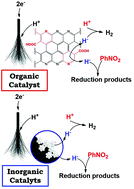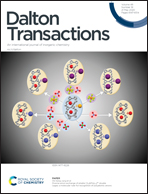Organocatalytic vs. Ru-based electrochemical hydrogenation of nitrobenzene in competition with the hydrogen evolution reaction†
Abstract
The electrochemical reduction of organic contaminants allows their removal from water. In this contribution, the electrocatalytic hydrogenation of nitrobenzene is studied using both oxidized carbon fibres and ruthenium nanoparticles supported on unmodified carbon fibres as catalysts. The two systems produce azoxynitrobenzene as the main product, while aniline is only observed in minor quantities. Although PhNO2 hydrogenation is the favoured reaction, the hydrogen evolution reaction (HER) competes in both systems under catalytic conditions. H2 formation occurs in larger amounts when using the Ru nanoparticle based catalyst. While similar reaction outputs were observed for both catalytic systems, DFT calculations revealed some significant differences related to distinct interactions between the catalytic material and the organic substrates or products, which could pave the way for the design of new catalytic materials.



 Please wait while we load your content...
Please wait while we load your content...